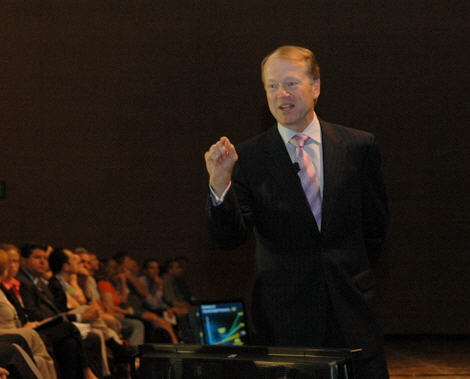Cisco CEO John Chambers proclaims the future is Web 2.0

Cisco CEO John Chambers ran on stage and then strolled throughout the crowd giving his vision of the networked future during his Network + Interop keynote presentation. As he walked and talked throughout the ballroom with the verbal passion and polish of a televangelist, Chambers proclaimed that Web 2.0, which he defined broadly as collaboration, is the future.
In other words, collaboration, enabled by the networking software and software that Cisco produces, will lead to an increase in productivity.
He defined the characteristics of collaboration as safe, open architecture, simple, virtualized and converged. “We are moving our company as fast as we can to collaboration and Web 2.0,” he said. “We see the next wave of productivity re-accelerating around the world.” Chambers views collaboration technology and other Web 2.0–related innovations as increasing productivity from 1 to 2 percent to 3 to 5 percent through 2012, just as the first wave of the Internet did from 1997 through 2002.
"It's an instant replay of over a decade ago," he explained. "It's not phase one , which took 12 to 15 years in terms of self service and ordering on line. It's the power of US [citing the recent Time Magazine person of the year]. Our world's ability to collaborate will determine the future of companies or countries."
He went on to say that consumers are driving product innovation and that social networking is the future.
"Web services, online social networks, unified communications, telepresence, podcasts, mashups, blogs, and peer to peer all combined--we already doing this across company with tremendous speed. Consumers are driving business. There are a lot of ideas with social networks, and we are changing the business from a formal hierarchy to informal social network council implementations," Chambers said, as proof that his company practices what he preaches. He demoed Cisco's Unified Communications System, including a social Web application that identifies experts within a company and locates them via a map and location presence mashup.
The high tech preacher's notion that Web 2.0 equals collaboration is an oversimplification, but Cisco is well position to profit as an infrastructure and applications provider from the social Web.
What caught my attention was Chambers saying that the future is in "how to gain the power of the group," and "balance command and control with collaboration and teamwork." It's not a technology problem, but a people problem. Chambers is a fast talker and believes in speed, especially in outpacing competitors by anticipating market trends, moving faster and increasing the company's $160 billion market cap. Chambers said that Cisco has been moving toward a blended organizational approach since 2001, and that with improved 'collaboration' the company will be able to tackle 16 to 20 new major initiatives, rather than just one or two as in the last year. He hopes that he can move to Cisco 3.0 before Web 2.0 winds down.
